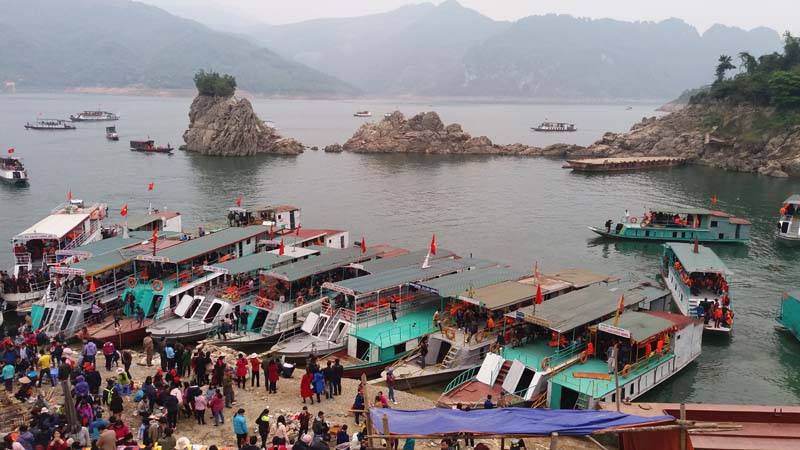
(HBO) – The upland district of Da Bac possesses many key potentials and advantages to develop tourism. The scenes are natural, wild, and majestic, with the significant landscape of Da River water in freshly green, the large and small islands are undulating on the water like "Ha Long on land".
![]()

Thac Bo Temple attracts a large number of
tourists.
The district has a rich and diverse natural
forest ecosystem, especially at Pu Canh Nature Reserve in the areas of Dong
Chum, Dong Ruong, Doan Ket, and Tan Pheo communes with a variety of precious
woods and populations of diverse animals and vegetation, whose values are
available for ecotourism development and scientific research. In particular,
this is the place where many ethnic groups have been living for a long time, including
four main ethnic groups of Tay, Muong, Kinh, and Dao. Each ethnic group has a
diverse culture, and typical identity. The villages are close to the nature
with custom activities, indigenous life style, and unique culture identities,
which are favorable for the development of community tourism.
In addition, the spiritual values are clearly
expressed in the lives of ethnic people. In particular, some typical places are
Thac Bo Temple - the provincial relics, Le Loi gravestone (Vay Nua commune),
which is a spiritual tourist attraction attracting thousands of visitors to
visit and go sightseeing at the beginning of the year. The district also has
national historical relics. In the district, there has initially formed many
major tourist attractions such as Bieu Mountain scenic spots, Lo Lan Cave, Ke
stream, Hien Luong commune; Sam Cave, Vom Cave, Toan Son commune; Ta Khop
waterfall, Dong Ruong commune; Than cave, Vay Nua commune; Lao Stream, Mua
Cave, Sung Cave, Cao Son Commune; Dua Island, Trang Trech village, Vay Nua
commune; Sung Cave (Robinson Tourism Destination), Tien Phong commune, etc.
Coming to Da Bac, visitors can come to the
community tourism destinations to be in harmony with nature beauty, feeling the
peaceful life, friendly and hospitable people through living activities,
costumes, unique ethnic cuisine in the village.
With the mobilization of all resources, the
potential and advantages of tourism have initially been exploited effectively
to contribute to improving the material and spiritual life of local people in
the area. Up to now, the district has 7 tourist accommodation establishments
with 47 guest rooms and 3 community tourism spots, 9 households doing community
service businesses in Hien Luong, Tien Phong and Cao Son communes.
A diverse chain of eco-tourism and resort destinations concentrated in Hoa Binh city and the districts of Tan Lac, Da Bac, and Luong Son… Along with the launch of several key high-quality resort tourism projects, these developments have reshaped the landscape and enhanced the appeal of Hoa Binh as a travel destination.
Boasting diverse terrain, a mild climate, and rich natural resources, Cao Phong district is increasingly asserting its place on Vietnam’s tourism map, attracting both domestic and foreign visitors. The district is renowned for its stunning landscapes, majestic mountains, a crystal-clear hydropower lake, and the unique cultural identity of local ethnic groups.
With its pristine landscapes, unique cultural heritage of Muong ethnic minority, and an expanding range of visitor experiences, Tan Lac district of Hoa Binh has fast become a captivating destination for both domestic and international tourists.
Until now, Sung village in Cao Son commune, Da Bac district remains the only Dao ethnic community in Hoa Binh province to develop a community-based tourism model. Beyond its untouched natural landscapes, cultural identity serves as the cornerstone attraction for visitors.
Alongside the diverse cultural identities of the Kinh, Muong, Tay, Thai, Dao, and Mong ethnic people, Hoa Binh province is also renowned as the "capital" of the northwestern Vietnamese cuisine, offering unique and distinctive dishes. At festivals, during Lunar New Year (Tet), or on significant family or community occasions, special dishes are prepared, leaving a lasting impression on visitors.
A Phong Linh (Yellow Tabebuia) flower garden in Thang village, Thach Yen commune, Cao Phong district is currently in full bloom, drawing a large number of visitors.



